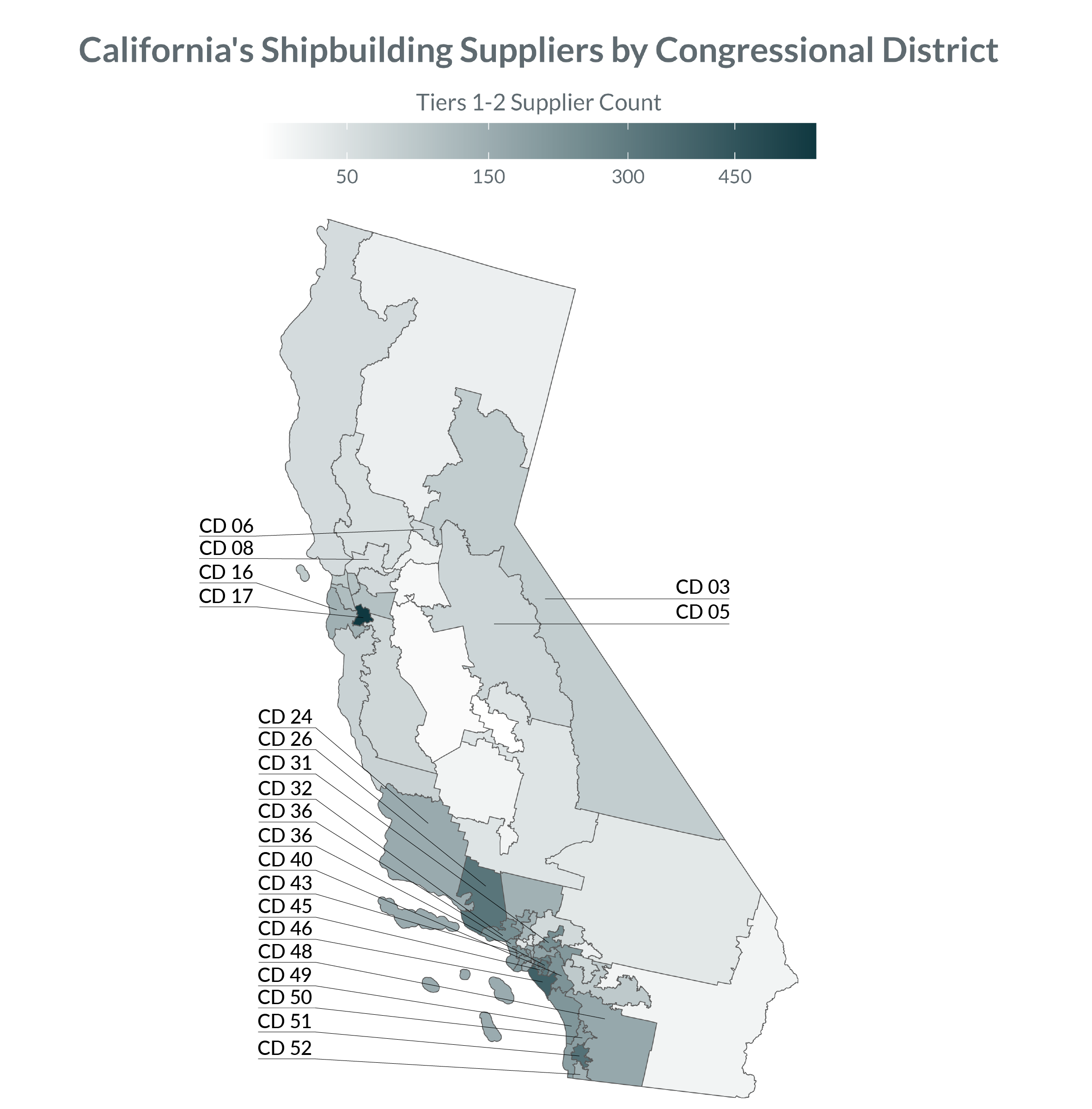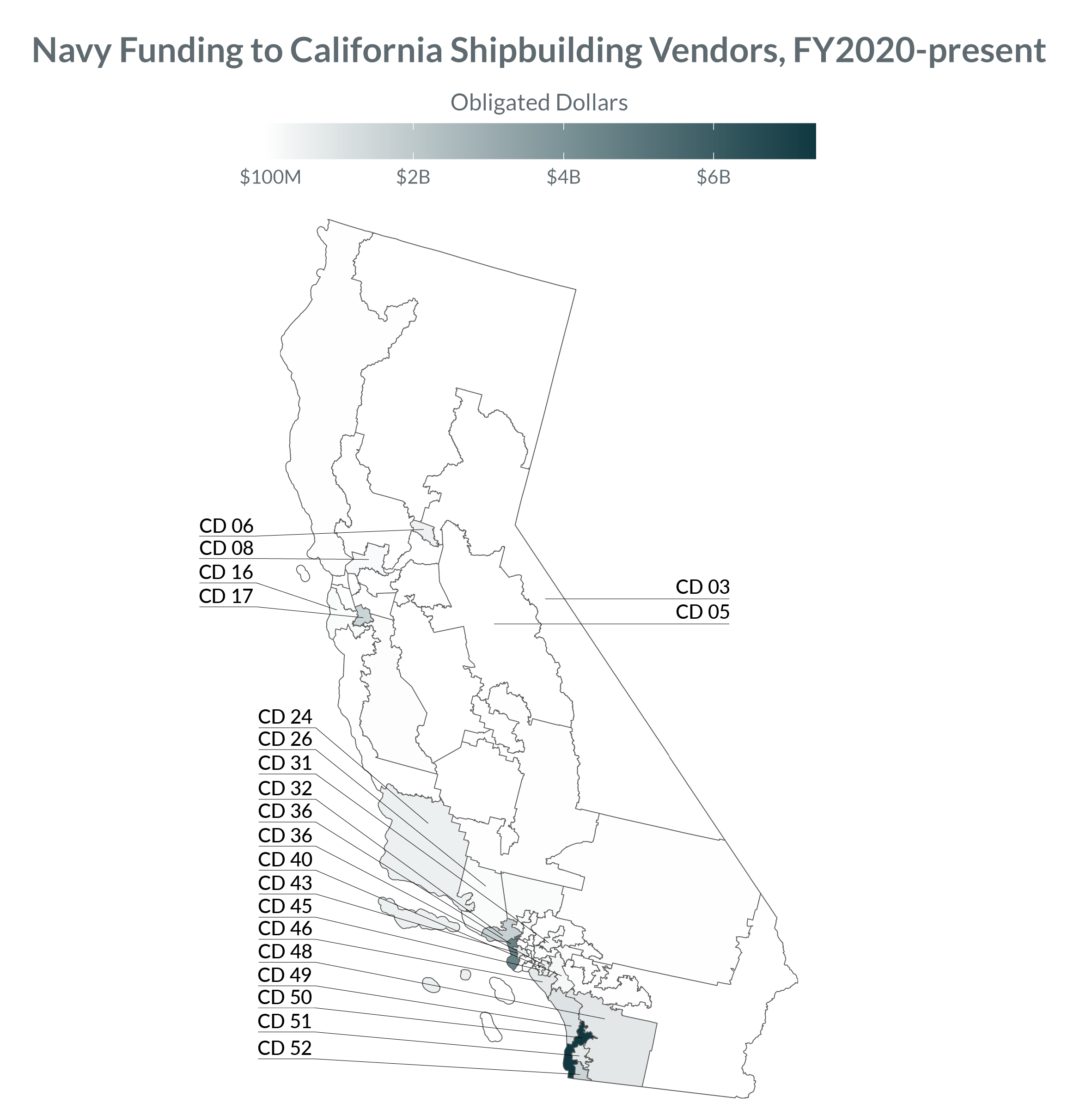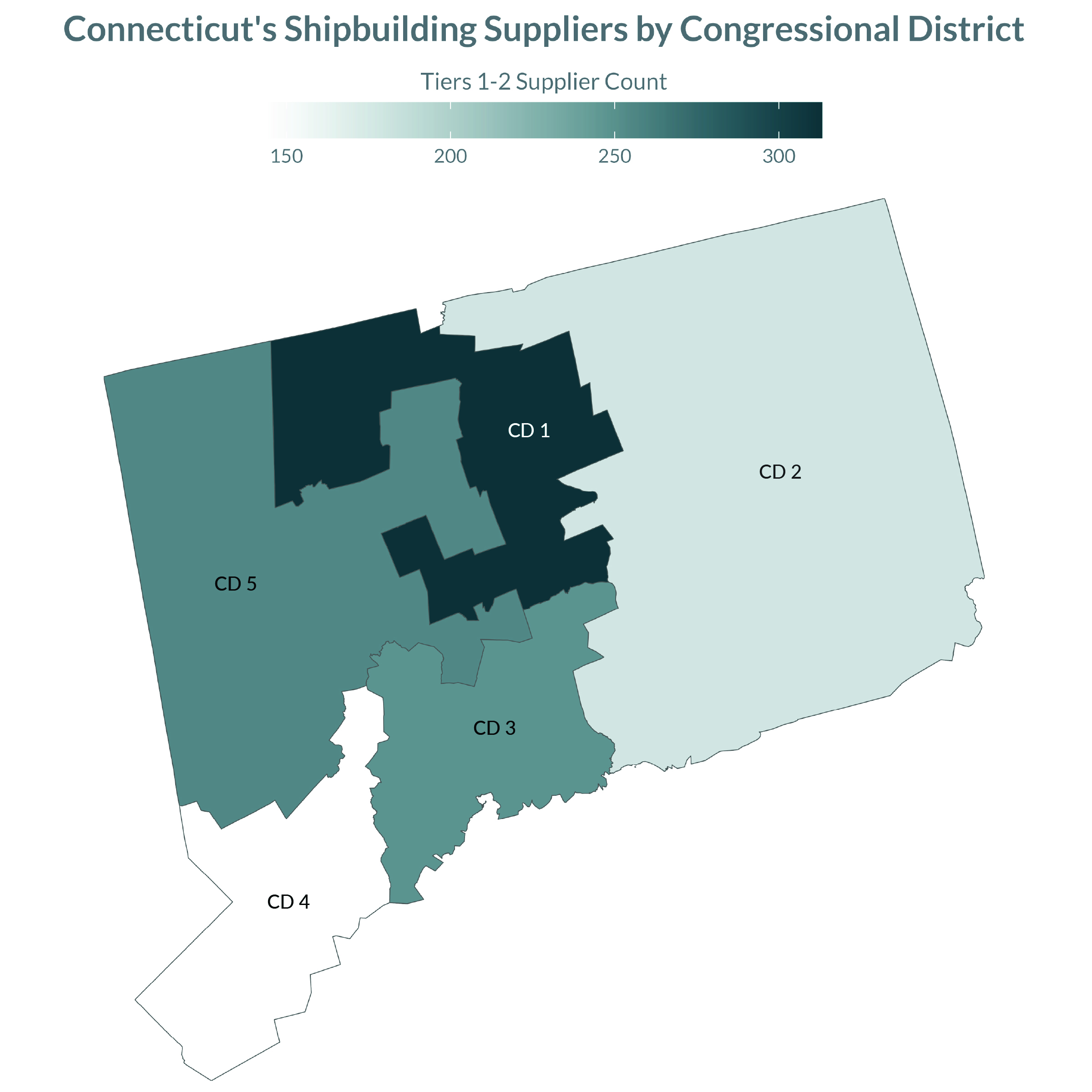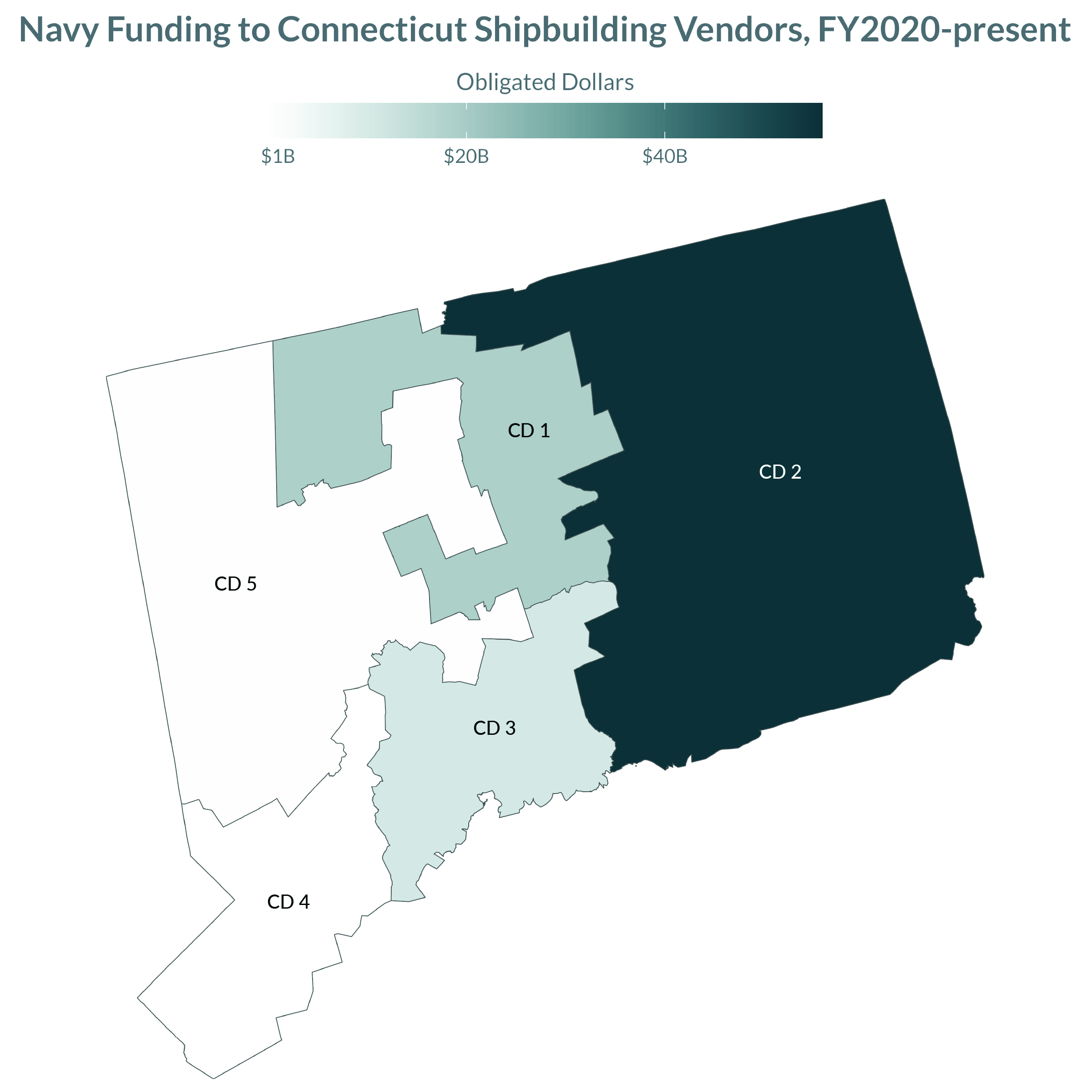A Nationwide Impact: How a Government Shutdown Threatens the U.S. Defense Industrial Base
INTRODUCTION
The economic damage of a government shutdown will extend far beyond Washington D.C. Navy shipbuilding is an ideal barometer for the shutdown’s impact on the entire defense industrial base. It encompasses tens of thousands of factories, machine shops, and manufacturing firms employing hundreds of thousands of American workers from across all 50 states. It plays a vital role in securing U.S. national security, military readiness, and deterrence.
An analysis of the Navy shipbuilding industrial base—including its first-and second-tier suppliers—reveals where the economic shock of a shutdown would be most severe. While the impact would be felt broadly, it would be concentrated in a handful of states such as California, Texas, Pennsylvania, Virginia, and Connecticut. Specific congressional districts, from California’s Silicon Valley to Connecticut’s defense corridor, would be acutely impacted, with hundreds of suppliers and billions of dollars in contract payments immediately jeopardized.
Looking beyond prime contractors to Tier 2 suppliers, there are tens of thousands of small- and medium-sized businesses downstream of Navy shipbuilding programs—from Arleigh Burke-Class Destroyers and Ford-Class Carriers to major systems like the MK 57 Vertical Launching System (VLS). Many of these are family-owned machine shops and component manufacturers that do not have the capital reserves to absorb the shock of delayed or canceled payments, making them highly vulnerable during a government shutdown. The large, nationwide distribution of shipbuilding suppliers underscores the industry’s broad-based impact on American jobs, manufacturing, and naval readiness.
Recognizing the critical nature of naval readiness, the Department of War has identified shipbuilding as a top priority and will likely take extraordinary measures to maintain operations during a shutdown. However, the extent to which these measures can fully insulate the broader shipbuilding industrial base from disruption remains a significant concern.
BROAD GEOGRAPHIC IMPACT, NOT JUST THE COASTS
While most people think of shipbuilding as a coastal industry, all states—including landlocked ones like Colorado and Arizona—are home to multiple companies supplying Navy ship programs. California alone has over 7,000 direct and indirect Navy suppliers, while states like Texas (2,804), Pennsylvania (2,681), New York (2,595) and Ohio (2,527) have thousands each. A shutdown would trigger a ripple effect across the country, jeopardizing thousands of skilled jobs and compromising a critical component of the U.S. defense infrastructure.

NOT JUST ABOUT BIG CONTRACTORS, BUT JOBS AND PAYCHECKS
Navy shipbuilding involves big defense primes as well as thousands of small- and medium-sized and family-owned businesses that do not have large commercial portfolios to absorb the shock of delayed or canceled payments. It directly and indirectly employs a massive skilled workforce. In California’s 17th Congressional District alone, over 500 companies depend on or are downstream of Navy contracts. Similar concentrations exist in districts across Virginia, Pennsylvania, New York, and Ohio. A shutdown doesn’t just stop work at major shipyards—it chokes off the flow of money to thousands of small-and medium-sized businesses that form the backbone of local economies nationwide. This creates both direct and indirect consequences for the Navy’s ability to maintain this critical, yet dwindling, supply of workers.

SHIPBUILDING IS REPRESENTATIVE OF THE BROADER DEFENSE INDUSTRIAL BASE
Navy shipbuilding involves a uniquely broad and intricate economic web of suppliers spanning all 50 states—not just coastal shipyards. Without a large commercial market to soften a downturn, the health of these communities is sustained through predictable defense funding. Since 2020, the Navy has driven massive investments in the shipbuilding industrial base: Texas ($89.8B), Connecticut ($85.1B), and Virginia ($55.0B) lead the way while California ($24.3B), Mississippi ($21.2B), and Massachusetts ($17.4B) have substantial stakes.
PINPOINTING THE GREATEST IMPACT OF A SHUTDOWN
While every state would be impacted by a shutdown, the economic pain would be most acute at the local level. The following congressional districts represent the most concentrated (based on the number of direct and indirect shipbuilding suppliers), and therefore most vulnerable parts of the entire shipbuilding industrial base:

Crucially, there are many districts like OH-10 that are home to a large number of indirect (Tier 2) shipbuilding suppliers. While such districts may not rank as highly in terms of direct Navy dollars awarded, they play a critical role in supporting the Navy’s prime contractors and are similarly affected by a government shutdown.
A CLOSER LOOK AT CALIFORNIA AND CONNECTICUT
CALIFORNIA: A SHOCKWAVE ACROSS MULTIPLE REGIONAL ECONOMIES
As the nation’s top shipbuilding hub with over 7,000 suppliers, California demonstrates how a shutdown would impact distinct and vital regional economies simultaneously. The supplier base isn’t confined to the major shipyards in San Diego; it is a sprawling network that includes Congressional Districts in the high-tech firms of Silicon Valley (CD 17, 583 suppliers), the manufacturing centers of Orange County (CD 47, 398 suppliers), and extending to the deserts of eastern California (CD 03, 83 suppliers). A shutdown doesn’t just threaten one industry; it sends a shockwave across the state’s entire tech and manufacturing base at once.


CONNECTICUT: A TWO-PRONGED ECONOMIC BLOW
Connecticut presents a different but equally critical picture of economic dependency. The supplier network is robust and widespread, with heavy concentrations in CD 1 (313 suppliers), CD 5 (255 suppliers), and CD 3 (248 suppliers). Suppliers in these districts represent a particularly important supply base for General Dynamics Electric Boat, which is located in Connecticut’s 2nd Congressional District. Home to Electric Boat and 177 other shipbuilding suppliers, CD 2 has captured the vast majority ($55.8B) of the $85.1B in prime Navy contracts awarded to Connecticut’s shipbuilding industrial base. Therefore, a government shutdown delivers a two-pronged blow to Connecticut: it freezes payments to hundreds of small-business suppliers across the state while simultaneously paralyzing the most important economic engine in the entire eastern half of Connecticut.


INTRODUCTION
The economic damage of a government shutdown will extend far beyond Washington D.C. Navy shipbuilding is an ideal barometer for the shutdown’s impact on the entire defense industrial base. It encompasses tens of thousands of factories, machine shops, and manufacturing firms employing hundreds of thousands of American workers from across all 50 states. It plays a vital role in securing U.S. national security, military readiness, and deterrence.
An analysis of the Navy shipbuilding industrial base—including its first-and second-tier suppliers—reveals where the economic shock of a shutdown would be most severe. While the impact would be felt broadly, it would be concentrated in a handful of states such as California, Texas, Pennsylvania, Virginia, and Connecticut. Specific congressional districts, from California’s Silicon Valley to Connecticut’s defense corridor, would be acutely impacted, with hundreds of suppliers and billions of dollars in contract payments immediately jeopardized.
Looking beyond prime contractors to Tier 2 suppliers, there are tens of thousands of small- and medium-sized businesses downstream of Navy shipbuilding programs—from Arleigh Burke-Class Destroyers and Ford-Class Carriers to major systems like the MK 57 Vertical Launching System (VLS). Many of these are family-owned machine shops and component manufacturers that do not have the capital reserves to absorb the shock of delayed or canceled payments, making them highly vulnerable during a government shutdown. The large, nationwide distribution of shipbuilding suppliers underscores the industry’s broad-based impact on American jobs, manufacturing, and naval readiness.
Recognizing the critical nature of naval readiness, the Department of War has identified shipbuilding as a top priority and will likely take extraordinary measures to maintain operations during a shutdown. However, the extent to which these measures can fully insulate the broader shipbuilding industrial base from disruption remains a significant concern.
BROAD GEOGRAPHIC IMPACT, NOT JUST THE COASTS
While most people think of shipbuilding as a coastal industry, all states—including landlocked ones like Colorado and Arizona—are home to multiple companies supplying Navy ship programs. California alone has over 7,000 direct and indirect Navy suppliers, while states like Texas (2,804), Pennsylvania (2,681), New York (2,595) and Ohio (2,527) have thousands each. A shutdown would trigger a ripple effect across the country, jeopardizing thousands of skilled jobs and compromising a critical component of the U.S. defense infrastructure.

NOT JUST ABOUT BIG CONTRACTORS, BUT JOBS AND PAYCHECKS
Navy shipbuilding involves big defense primes as well as thousands of small- and medium-sized and family-owned businesses that do not have large commercial portfolios to absorb the shock of delayed or canceled payments. It directly and indirectly employs a massive skilled workforce. In California’s 17th Congressional District alone, over 500 companies depend on or are downstream of Navy contracts. Similar concentrations exist in districts across Virginia, Pennsylvania, New York, and Ohio. A shutdown doesn’t just stop work at major shipyards—it chokes off the flow of money to thousands of small-and medium-sized businesses that form the backbone of local economies nationwide. This creates both direct and indirect consequences for the Navy’s ability to maintain this critical, yet dwindling, supply of workers.

SHIPBUILDING IS REPRESENTATIVE OF THE BROADER DEFENSE INDUSTRIAL BASE
Navy shipbuilding involves a uniquely broad and intricate economic web of suppliers spanning all 50 states—not just coastal shipyards. Without a large commercial market to soften a downturn, the health of these communities is sustained through predictable defense funding. Since 2020, the Navy has driven massive investments in the shipbuilding industrial base: Texas ($89.8B), Connecticut ($85.1B), and Virginia ($55.0B) lead the way while California ($24.3B), Mississippi ($21.2B), and Massachusetts ($17.4B) have substantial stakes.
PINPOINTING THE GREATEST IMPACT OF A SHUTDOWN
While every state would be impacted by a shutdown, the economic pain would be most acute at the local level. The following congressional districts represent the most concentrated (based on the number of direct and indirect shipbuilding suppliers), and therefore most vulnerable parts of the entire shipbuilding industrial base:

Crucially, there are many districts like OH-10 that are home to a large number of indirect (Tier 2) shipbuilding suppliers. While such districts may not rank as highly in terms of direct Navy dollars awarded, they play a critical role in supporting the Navy’s prime contractors and are similarly affected by a government shutdown.
A CLOSER LOOK AT CALIFORNIA AND CONNECTICUT
CALIFORNIA: A SHOCKWAVE ACROSS MULTIPLE REGIONAL ECONOMIES
As the nation’s top shipbuilding hub with over 7,000 suppliers, California demonstrates how a shutdown would impact distinct and vital regional economies simultaneously. The supplier base isn’t confined to the major shipyards in San Diego; it is a sprawling network that includes Congressional Districts in the high-tech firms of Silicon Valley (CD 17, 583 suppliers), the manufacturing centers of Orange County (CD 47, 398 suppliers), and extending to the deserts of eastern California (CD 03, 83 suppliers). A shutdown doesn’t just threaten one industry; it sends a shockwave across the state’s entire tech and manufacturing base at once.


CONNECTICUT: A TWO-PRONGED ECONOMIC BLOW
Connecticut presents a different but equally critical picture of economic dependency. The supplier network is robust and widespread, with heavy concentrations in CD 1 (313 suppliers), CD 5 (255 suppliers), and CD 3 (248 suppliers). Suppliers in these districts represent a particularly important supply base for General Dynamics Electric Boat, which is located in Connecticut’s 2nd Congressional District. Home to Electric Boat and 177 other shipbuilding suppliers, CD 2 has captured the vast majority ($55.8B) of the $85.1B in prime Navy contracts awarded to Connecticut’s shipbuilding industrial base. Therefore, a government shutdown delivers a two-pronged blow to Connecticut: it freezes payments to hundreds of small-business suppliers across the state while simultaneously paralyzing the most important economic engine in the entire eastern half of Connecticut.





